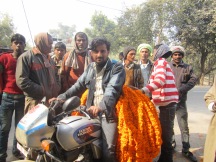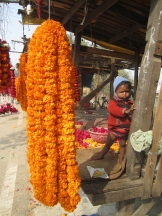Archive for the ‘Green Kumbh’ Category
Some Reflections
It is a bit surreal to think that we have already been back to Cambridge, back to classes and meetings and syllabi, for a whole week. By comparison, the few days we spent at the Kumbh Mela pursuing our various forms research somehow seem more meaningful, densely packed as they were with experiences and discoveries. My own project was concerned with the role of trees and tree-related traditions in the discourse and activities of environmental and developmental initiatives present at the festival. I was hoping to perhaps document the giving out of some planting material and the veneration of certain established trees, in addition to obtaining more detailed information about the ideas and ideologies as well as practical logistics behind such activities.
Yet what I found once at the Mela went far beyond a few sound bites about tree planting or a smattering of sacred saplings. Throughout the enormous fair grounds there were plants – rows and rows of potted Norfolk pines and palms, dahlias, chrysanthemums, and roses, impromptu lawns laid out in freshly germinated grain and cleanly edged In brick. Many an encampment sported full-out landscaping, with not only formal lawns but creatively laid out pathways, sculptures, and fountains, even artificial trees and hills. I stumbled across the stall of the state-run Horticulture and Food Sciences Research Center at the edge of the fair grounds – they, too, will be giving out tree saplings towards the end of the fair, guava plants to be precise. Not with a specific environmental aim but simply because Allahabad is famous for its guavas and they therefore make a fitting souvenir for visitors. I also visited some of the many nurseries in Allahabad proper and talked to their staff about their dealings with the Kumbh Mela encampments. They all said they have been selling large numbers of potted plants – hardy foliage favorites that can take neglect and popular flowers like chrysanthemums for color – to the camps. Yet while admitting that business was good, they also all showed a certain ambivalence about these sales, as if they regretted submitting their carefully reared plants to an almost certain death in the dusty, smoky, and – worst of all – temporary camps. Every nursery man and woman I spoke to emphasized the transient nature of the event, often with an almost angry precision – “fifty days only, then everything is thrown away!” – as if it were a moral flaw. And perhaps to plant people, accustomed to propagating and nurturing in accordance with nature’s slower cycles of growth, that is what it is.
The importance of these cycles even in the temporary city occasioned by the Kumbh Mela was brought home in a conversation with the sadhu Prahlad Puri of the Juna Akhara. Asked what he does with the marigold garlands used for worship and decoration once they have served their purpose, he said that “since they are given with love, they cannot be thrown away but have to be put in a respectful place, so I put them in the Ganga or hang them on a tree… You cannot bury them in the ground because they are full of seeds. Marigold plants will germinate everywhere”. And sure enough, on a sandbank in the middle of the Sangam of Ganga and Yamuna (and Saraswati) where flower offerings are washed up and where the volunteers of Swami Chidananda Saraswati’s Green Kumbh initiative were burying garlands collected along the edge of the river, there were hundreds of marigold seedlings, emerging singly and in bunches, the product of people’s devotion and the nurturing waters of the sacred rivers, but also of the latter’s inadvertent pollution.
Toilets, Poop, and Sanitation at the Kumbh Mela
By Stephanie Cheng, PharmD, MPH Candidate 2013 – Harvard School of Public Health
When I found out that I was going to the Kumbh Mela to map toilets and sanitation at the Kumbh, I wouldn’t say I was exactly jumping for joy and cringed slightly at the thought of wandering around the Kumbh taking pictures of toilets and asking strangers personal questions about their bathroom habits. Not exactly a glamorous topic. However, considering the massive scale of migration of people from all over the world to this relatively small and compact area, water and sanitation becomes a huge public health issue in terms of preventing the spread of diseases, particularly those associated with waste and improper sanitation such as cholera.
The water and sanitation team, which consisted of Dr. Richard Cash, Candace Brown and myself from Harvard School of Public Health and Leila Shayegan from Harvard University Faculty of Arts and Sciences, would not proclaim ourselves as experts on toilets. However by the end of our visit, we could confidently identify the various types of bathroom facilities. The variety of facilities takes into consideration the fact that pilgrims come from all sorts of backgrounds and are use to a wide variety of toilets. A sign designates which toilets are for males and which are for females. Read the rest of this entry »
mapping the marigolds
After a twenty-minute drive from the Sangam out of the Kumbh’s main grounds, we reached the flower market I’d been hoping existed. A flower seller in Sector 4 thought her garlands came from Gau Ghat, and so our search began. Our driver remained visibly befuddled by our directions and objective throughout the morning, but following a few inquiries he was successfully directed by locals past a main market and ferris wheel lot toward the city of Naini. After passing a truck piled with orange buds traveling in the opposite direction, I knew we were going the right way. Pulling up to this market it was clear we’d reached something bigger and more established than the market we’d been to in Varanasi. Wooden booths stood in rows along the main road and each had a sizable stock. In addition to the 30 or so stands I saw lining each side of the road and a fork in between, men stood above piles of loose buds and garlands resting on scarves. I counted about 16 piles and 10 men standing above them. Women did not seem present in this method of sale but were rather perched inside stalls, stringing roses. My method was to approach each seller who reciprocated a smile and seemed receptive to my clasped hands. The first woman was helpful, friendly, and eager to talk. Our very kind driver decided we were struggling (or continued to think we were crazy) and came over after a couple of minutes. With his and Nicholas’ translation help, we were told that the market opens at 7am and closes at 10am, though it was then 11am and clearly open. The woman reported there were 100-150 vendors and she saw 200 buyers each morning, making roughly 1000 rupees per day. There wasn’t a typical sale- people bought both garlands in bulk and single strands. She’d been here for the last Kumbh and didn’t see a difference in demand based on this year’s sales. The marigolds and roses came from Allahabad and the chrysanthemums from Kanpur. Nearby, a motorcycle loaded with saffron-colored garlands took off in the direction from which we’d come, headed to a “store nearby.” From the next sellers we heard conflicting reports. Minivans came at 5am after collecting flowers from trucks. No, ten trucks came directly and everyone at the market bought from them. One-hundred-fifty sellers. No, 500. No, 1500. Two-thousand regular customers. The market didn’t close at 10am but rather noon. We only saw one actual customer, who was standing by as loose rose petals and four red and orange garlands were packed into a blue plastic bag a few meters from a “no polyethylene” sign. Overall, the market scene from 11-11:30am consisted of 30-40 booths with a woman or two in each, 20 men standing over twice as many flower piles, 5 motorcylces and a few more bikes, one customer, one cow, one goat, one baby single-handedly manning a stall, and three westerners with their perplexed driver.
Sacred Sapling
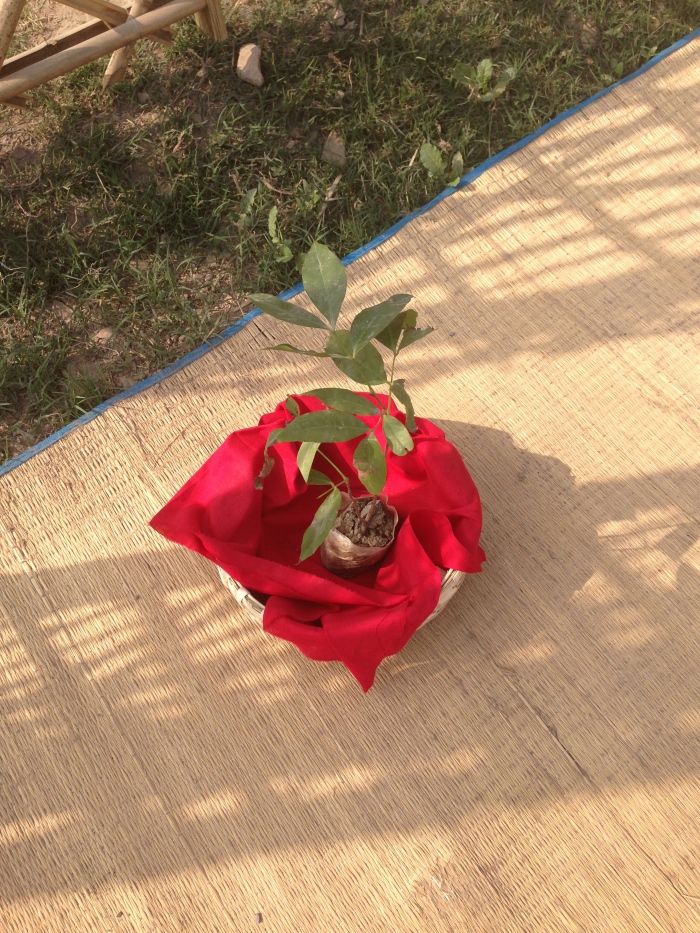
Professor Eck received this sapling as prasad at a launch event for Swami Chidananda Saraswati’s Green Kumbh Initiative. We planted it at Lakshmi Kutir camp yesterday.
Kumbh Mela, January 19, Diana Eck
Kumbh Mela, January 19
Today we spent time in two different kinds of camps. In the morning, we went into the sector nearest the sangam where the ascetic renunciants live in their akharas. Near the main gate of the largest, the Juna Akhara, we met with Rampuri who has been present at Kumbh Mela for the past 42 years. Born in California and a long-time initiate in the Juna Akhara, Rampuri has both the experience and perspective to be a bridge to the world of our students. We sat for most of the morning around his dhuni, his altar-fireplace, and listen to him respond to our questions about the meaning of the Kumbh Mela and the life of the Juna Akhara. Rahul’s group came late in the morning and worked on the quadrant layout of the whole of the Juna Akhara.
In the afternoon, we went across a long pontoon bridge to the camp of Swami Chidanand Sarasvati, who was launching an effort of the Ganga Action Parivar at the Kumbh. The Governor of the Uttaranchal was there, known widely as the Green Governor, as were mayors of several of the cities along the Ganga, including the mayor of Allahabad. It was a strong indication that cleaning the Ganga will involve not just spiritual commitment, but the leadership of those who deal with urban infrastructure along the River. We had a discussion afterwards with Sadhvi Bhagavati Sarasvati, a Stanford graduate who has been part of the ashram for some sixteen years, and were received at the end of our visit by Swami Chidanand-ji himself. Students keen on understanding the Green Kumbh movement are eager to come back, which we will. 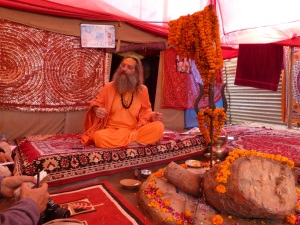
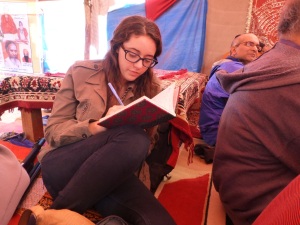
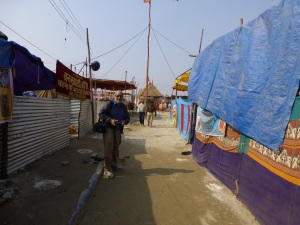

The end-of-the day reports from the four research teams out in Kumbh Nagar today were fascinating.
Sacred Trees at the Kumbh Mela
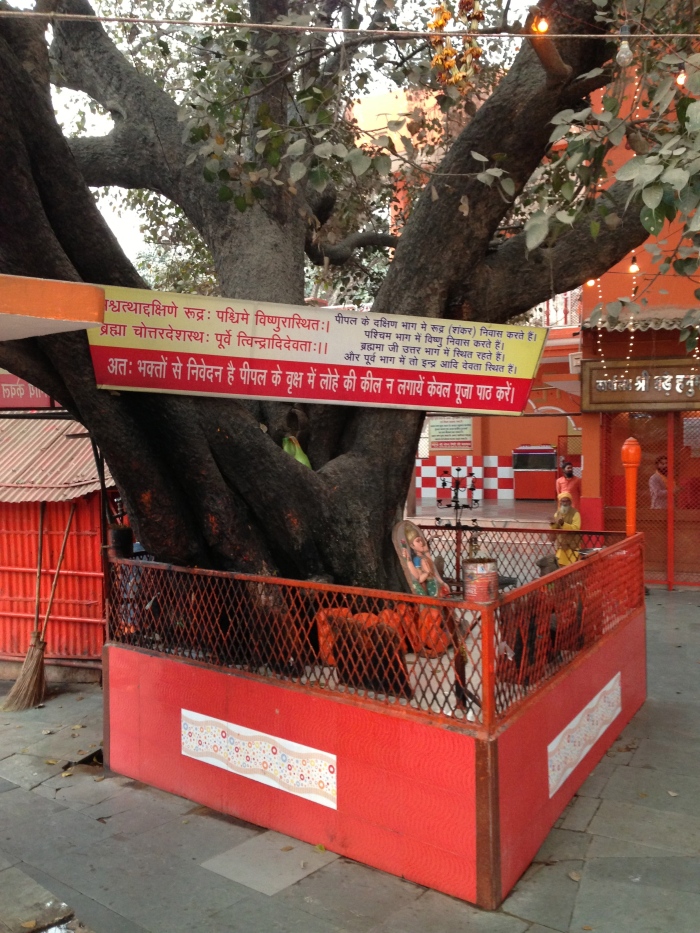
A sacred peepal (Ficus religiosa) at a Hanuman Temple at the edge of the Mela Grounds towards the city of Allahabad proper; the sign reads, in Sanskrit on the left and Hindi on the right, “Shiva resides in the southern portion of the peepal tree, Vishnu lives in its western part, Brahma is located in the northern part, and in the eastern part is Indra”. The line of Hindi running along the bottom asks devotees not to put iron nails in the tree but only to perform puja, a request perhaps meant to apply not just to this specimen but to peepal trees in general.
A Tree in the City
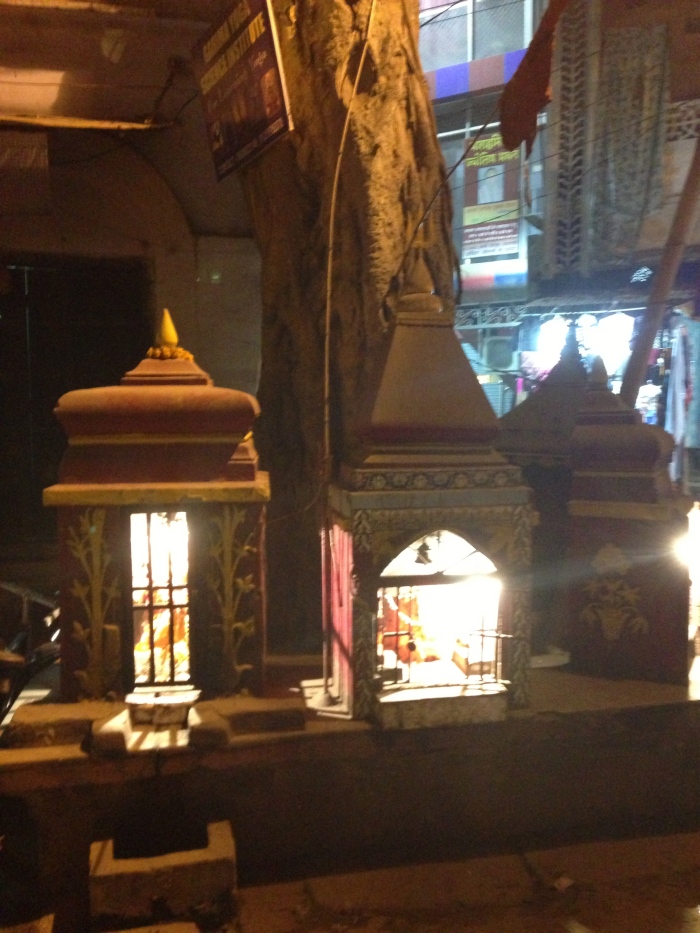
Brightly lit shrines under a peepal tree (Ficus religiosa) in the streets of Varanasi

